For sun cooking, you'll want containers made of borosilicate glass or high-grade stainless steel that can withstand temperatures up to 600°F. These materials offer superior heat resistance while preventing harmful chemical leaching. Choose options with airtight silicone gaskets to lock in freshness and keep out moisture. Double-walled designs with proper insulation will help maintain consistent cooking temperatures, while UV-protective tinting can preserve your rice quality during storage. Look for features like built-in measuring cups and stackable designs to maximize convenience. Understanding the full scope of container features will help you make the most of your solar cooking experience.
Why Heat-Resistant Containers Matter
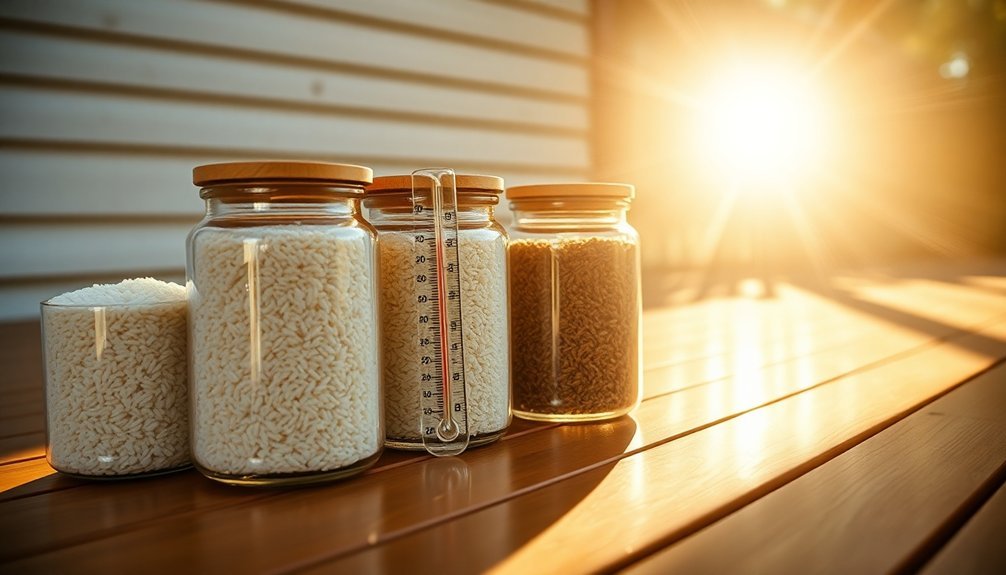
In addition to storing rice, heat-resistant containers play an essential role in solar cooking applications. When you're using a solar cooker, you'll need containers that can withstand temperatures ranging from 140 to 600 degrees Fahrenheit without melting, deforming, or releasing harmful chemicals.
These specialized containers are typically crafted from durable materials like glass, ceramic, or metal to guarantee your safety and cooking success. Following the principles established by Horace deSaussure's experiments, these containers incorporate insulation and heat-trapping features that have proven effective since the 1700s.
You'll find that heat-resistant containers greatly improve your solar cooking efficiency through their superior heat retention capabilities. They work with your solar cooker's insulation and airtight seals to minimize heat loss, which means you won't need to constantly monitor or adjust your cooking setup.
When paired with reflective surfaces, these containers help maintain consistent cooking temperatures and distribute heat evenly throughout your food.
The containers' design integrates seamlessly with various solar cooker types, including box cookers and concentrating cookers. They're compatible with transparent covers that allow sunlight to pass through while trapping heat inside.
Whether you're cooking rice, dehydrating fruits, or preparing complete meals, heat-resistant containers give you better temperature control and provide safer handling during the cooking process.
Top Glass Container Options
When you're looking for glass containers to store rice, heat-resistant options stand out for their ability to withstand temperature changes without compromising the airtight seal.
You'll find that borosilicate glass containers offer superior thermal shock resistance, making them perfect for moving between different storage environments.
Modern stackable designs often incorporate UV-protective tinting, which helps preserve your rice's quality while maximizing vertical storage space. The Sur La Table glass container sets provide reliable storage solutions with their durable construction and secure sealing features.
Heat-Resistant Glass Features
Glass storage containers with heat-resistant features stand out as premium options for rice storage, thanks to their exceptional thermal properties. Made from borosilicate glass, these containers can withstand extreme temperature variations without compromising their structural integrity. You'll find they're safe to use in boiling water, dishwashers, microwaves, and ovens up to 400℃, making them versatile for various cooking methods.
Key features that make heat-resistant glass containers superior include:
- Thermal shock resistance that prevents cracking when moving from hot to cold environments
- Chemical-free composition that won't leach harmful substances into your stored rice
- Nonporous surface that maintains rice freshness while preventing odor absorption
The 2021 Red Dot Award winner showcases exceptional design quality in heat-resistant glass containers for optimal rice storage. The containers' airtight sealing system, often featuring silicone gaskets, guarantees your rice stays fresh and protected from moisture.
When you're cooking rice directly in these containers, you'll appreciate their ability to handle high temperatures safely. The clear glass construction lets you monitor your rice's condition without opening the container, while the durable build ensures long-lasting performance.
For sun cooking enthusiasts, these heat-resistant properties make them particularly valuable, as they can endure prolonged exposure to high temperatures without degradation.
Stackable UV Protection Designs
Through innovative engineering, modern stackable glass containers with UV protection offer the ideal blend of functionality and preservation. You'll find these containers particularly valuable for organizing your pantry while safeguarding your rice from harmful UV rays.
The stackable design maximizes your storage space, letting you store multiple containers vertically without compromising accessibility.
When selecting your rice storage solution, look for glass containers that feature UV-protective coatings or materials that inherently block ultraviolet light. These specialized containers maintain visibility while preventing light degradation, ensuring your rice stays fresh longer.
The best options combine airtight seals, typically using high-quality silicone gaskets, with UV protection to create a thorough storage system.
You'll appreciate how these containers work together, allowing you to stack different sizes without worrying about stability. The durable construction supports multiple layers, while user-friendly mechanisms like push-button lids make access effortless.
For ideal rice storage, choose containers that incorporate both stackable features and UV protection – they'll help maintain your rice's quality while keeping your pantry organized and efficient.
Plastic Versus Metal Storage
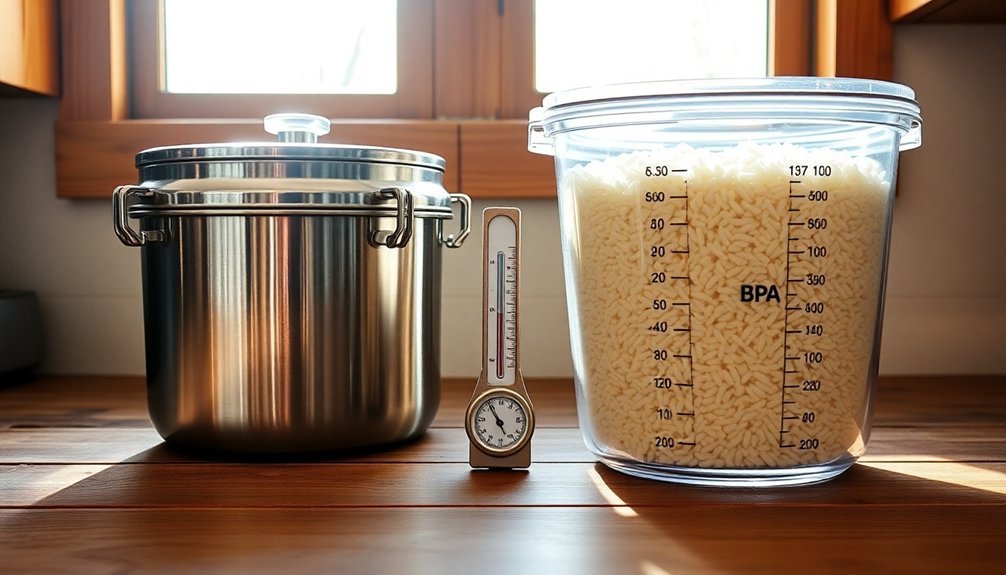
Choosing between plastic and metal storage containers involves weighing several key factors that affect your rice's freshness and safety.
When considering plastic options, you'll find BPA-free clear containers that offer visibility and lightweight handling. These containers often come with user-friendly features like push-button lids and stackable designs that maximize your storage space.
Key differences between plastic and metal containers include:
- Plastic containers are more versatile, suitable for both dry and cooked rice storage, including refrigeration.
- Stainless steel offers superior durability and natural pest resistance.
- Clear plastic provides immediate visibility, while metal containers typically need glass or acrylic lids for content viewing.
Metal containers, particularly those made of stainless steel, deliver exceptional durability and corrosion resistance. They're non-reactive and won't affect your rice's taste or quality.
However, it's essential to avoid metal containers made from reactive materials that could compromise your rice's freshness.
While plastic containers are generally less expensive and more lightweight, metal options provide better protection against pests and moisture.
You'll find both options work well for long-term storage, but your choice might depend on specific needs like visibility, durability, and budget constraints.
Best Airtight Seal Designs
When it comes to airtight seal designs, quality containers stand out with distinct mechanisms that lock in freshness. You'll find several effective sealing systems, with vacuum-sealed options offering the longest preservation – up to six months when unopened.
Rubbermaid Brilliance's snap-on lids have proven particularly reliable, maintaining their seal even when shaken vigorously with rice inside.
For maximum protection, you'll want to look for containers featuring silicone gaskets, like those used in Aroma housewares products. These gaskets create a superior seal that maintains both freshness and flavor.
The locking clamp mechanism, found in Auggie's stainless steel containers, provides another layer of security that's especially useful if you're handling larger quantities of rice.
Push-button and pop-on lid designs have also shown impressive results in testing. Rubbermaid's pop-on lids with push-down buttons consistently perform well in leak tests and maintain their integrity through multiple uses.
If you're specifically looking for leak-proof performance, these containers have demonstrated their ability to prevent spills even when filled with water and vigorously shaken.
Temperature Control During Storage
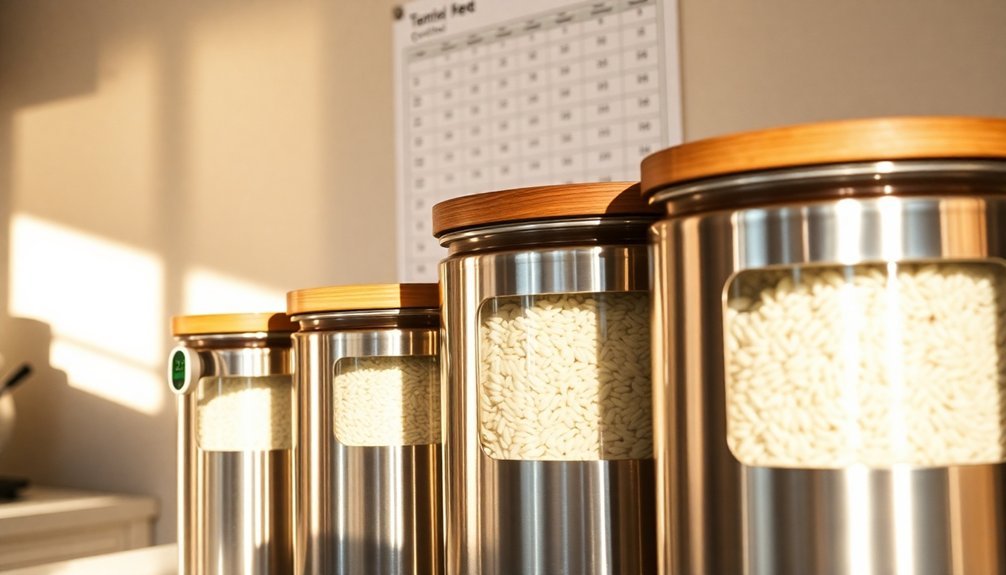
To protect your rice from heat damage, store containers away from direct sunlight, heating vents, and appliances that generate warmth.
You'll want to choose storage containers with double-wall insulation or those made from temperature-regulating materials like paulownia wood or high-grade plastic.
Adding a layer of insulation around your rice container, such as wrapping it in a heavy cloth or placing it inside a larger insulated box, can help maintain consistent temperatures during seasonal changes.
Heat Damage Prevention Measures
Protecting your rice from heat damage requires careful attention to temperature control during storage. You'll need to maintain temperatures between 15-25°C (59-77°F) to prevent chemical reactions that can degrade your rice quality.
Keep your storage containers away from direct sunlight and heat sources, as these can create temperature fluctuations that promote spoilage and insect activity.
Select a storage location that offers consistent temperature control and good ventilation. You'll want to monitor the temperature regularly using thermometers to verify it stays within the ideal range. If you're storing cooked rice, refrigerate it at or below 4°C (39°F) within a day of cooking.
Key measures to prevent heat damage include:
- Position containers away from windows, doors, and heating vents to avoid temperature fluctuations
- Use airtight, insulated containers that shield rice from external temperature changes
- Install fans or aeration systems to maintain even temperatures throughout storage areas
During warmer months, consider operating aeration systems at night when temperatures are cooler. This practice helps maintain consistent temperatures and prevents moisture migration that can lead to spoilage.
Remember to check your storage area regularly for any signs of heat exposure or temperature inconsistencies.
Insulation Materials And Methods
The right insulation materials and methods make all the difference in maintaining stable temperatures for your stored rice. For ideal storage, you'll want to focus on both passive and active insulation approaches. Mineral wool, offering excellent thermal resistance at 100mm thickness, and PIR insulation, ranging from 40-60mm, are your primary material options.
You can enhance your storage container's efficiency by implementing passive methods like air chambers and white paint coating to reduce solar radiation. Installing sheet metal lining or external sheets creates an additional barrier against temperature fluctuations. For maximum protection, consider using ceramic paints on your container's surface, as they provide high thermal resistance.
Don't overlook active temperature control systems. You'll need proper ventilation and air circulation to prevent warm air pockets. If you're storing rice for longer periods, consider using coolers or refrigeration systems to maintain temperatures at or below 4°C. Regular temperature monitoring is vital to guarantee consistent conditions.
When installing insulation, focus on strategic placement. You can insulate the entire structure or specific areas like the cylinder and roof, depending on your needs. For floor protection, a 50mm XPS layer provides robust thermal protection.
Portable Solar Rice Storage
Numerous portable rice storage containers now incorporate solar-powered features for enhanced preservation during outdoor activities. When you're camping or traveling, you'll find these containers particularly useful as they combine lightweight durability with sun-protective properties.
The BPA-free plastic and stainless steel materials help shield your rice from harmful UV rays while maintaining ideal storage conditions.
For outdoor enthusiasts, these portable containers offer several key advantages:
- Built-in airtight seals with silicone gaskets protect your rice from moisture and pests, even in varying outdoor temperatures
- Compact dimensions and stackable designs make them perfect for packing in your camping gear or RV storage
- Clear visibility lets you monitor rice levels without opening the container, reducing exposure to outdoor elements
You'll appreciate how these containers maintain freshness during extended outdoor stays. With capacities around 2.8 kg, they're ideal for weekend camping trips or longer expeditions.
The push-button lids make accessing your rice convenient, while the included measuring cups guarantee precise portions.
When selecting a solar rice storage container, look for ones with high-quality construction that can withstand temperature fluctuations and rough handling during outdoor activities.
UV Protection Features
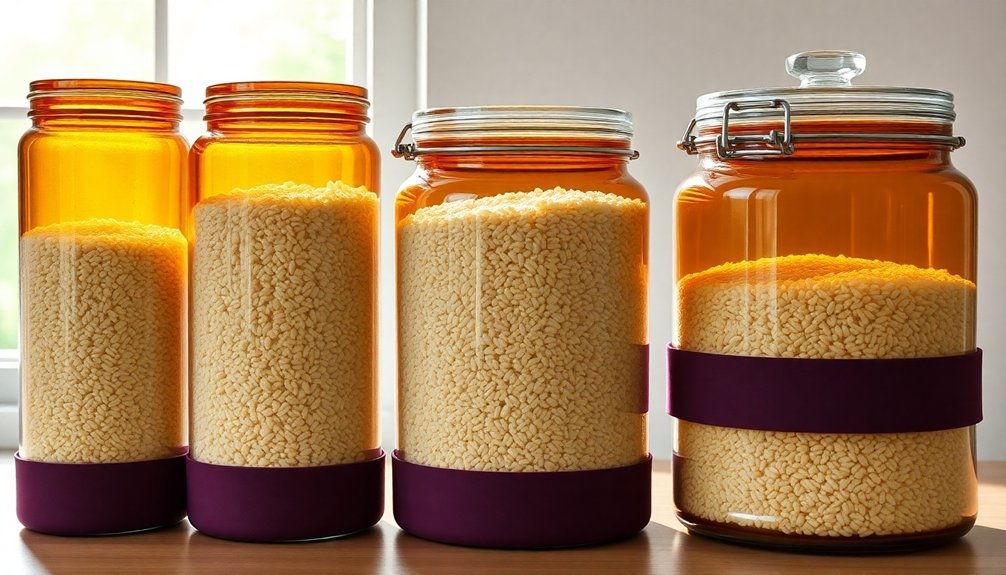
Building on solar protection capabilities, effective UV protection features in rice storage containers play an essential role in preserving your rice's quality and nutritional value. You'll want to select containers made from non-reactive, BPA-free materials that offer robust UV protection through either opacity or specialized tinting. Look for thick-walled containers with multi-layer construction and UV-resistant coatings.
The most effective UV protection comes from combining proper materials with smart design features. You'll find the best results with containers that incorporate airtight seals and reinforced silicone rings to prevent UV-induced degradation.
| Feature | Benefit | Implementation |
|---|---|---|
| Opaque Materials | Blocks UV penetration | Choose ceramic or colored containers |
| Multi-layer Design | Enhanced protection | Select containers with dual-wall construction |
| UV-resistant Coating | Direct light blocking | Look for specially treated surfaces |
| Airtight Seals | Prevents degradation | Check for silicone ring reinforcement |
| Stackable Design | Minimizes exposure | Use interlocking container systems |
For maximum protection, you'll need to take into account storage location alongside container features. Place your containers in shaded areas, deep cabinets, or use additional covers when needed. Regular rotation of your rice stock helps guarantee even protection across your storage system.
Moisture Prevention Systems
Your best defense against moisture damage in rice storage comes from containers with multi-layer humidity barriers, which combine materials like mylar and food-grade plastic to create an impenetrable shield.
You'll find the most effective solutions incorporate smart condensation control systems that actively prevent water droplets from forming inside the container.
These advanced moisture prevention features work together with proper sealing mechanisms to maintain the ideal 12% moisture content that's essential for long-term rice storage.
Multi-Layer Humidity Barriers
Modern multi-layer humidity barriers, particularly those found in Mylar storage bags, provide exceptional moisture protection for your rice through their sophisticated construction. The key to their effectiveness lies in the BoPET film that's stretched in two directions, creating a remarkably strong and flexible barrier.
When combined with an aluminum coating, these layers work together to block moisture, light, and other harmful elements that could compromise your rice's quality.
To maximize your rice's storage potential, you'll want to understand these important features of multi-layer barriers:
- The thickness of 3.5 to 7 mils offers varying levels of protection, with thicker options providing enhanced moisture resistance
- Heat-sealed closures create an airtight environment that prevents water vapor from penetrating
- Oxygen absorbers can be added inside to further protect against moisture and prevent mold growth
When you're storing rice for sun cooking, these barriers are particularly essential as they maintain the grain's integrity through multiple heating cycles.
The non-reactive nature of Mylar guarantees your rice stays fresh without any taste alterations, while the opaque, reflective surface protects against UV degradation that could affect cooking performance.
Smart Condensation Control Systems
Smart condensation control systems represent a sophisticated approach to protecting your stored rice from moisture damage.
You'll want to integrate wireless monitoring capabilities that automatically track humidity levels and adjust ventilation accordingly. These systems work in tandem with strategically placed vents at different heights, allowing warm, moist air to escape while maintaining consistent internal temperatures.
To enhance your moisture control, you'll need to incorporate CO2 sensors that can detect early signs of grain deterioration.
These sensors work alongside digital moisture content monitors that use advanced algorithms to maintain ideal storage conditions. You can also install automatic aeration controls that respond to changes in relative humidity and temperature.
For added protection, you'll benefit from combining active and passive moisture control methods.
Install heat lamps on timers to periodically dry the air, and use moisture-absorbing packs between ventilation cycles.
Make sure your storage containers feature hermetic sealing systems that prevent oxygen and water movement.
To maximize effectiveness, insulate your containers properly while ensuring they allow for necessary drainage and electrical modifications for your smart monitoring equipment.
Rice Capacity Planning
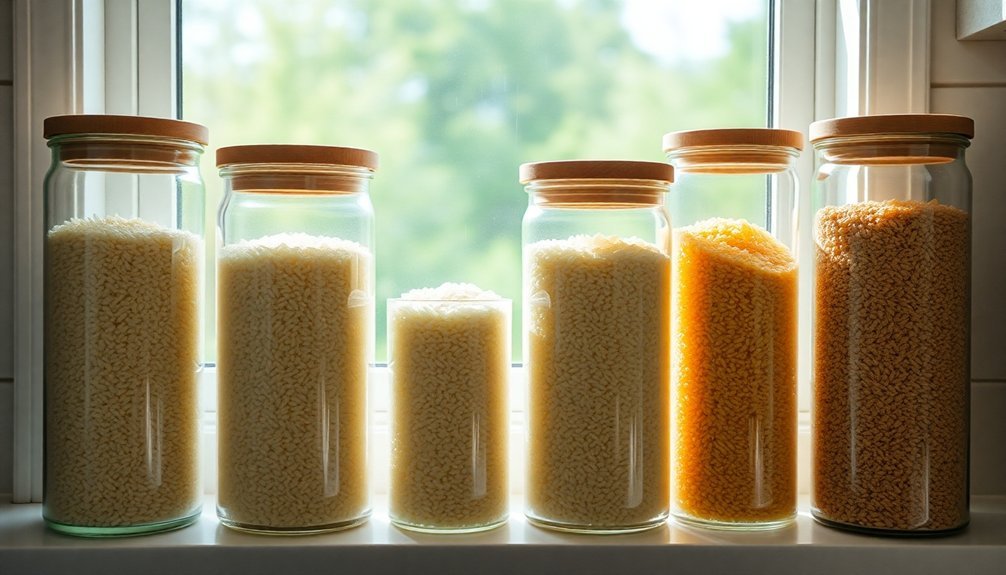
Planning the right rice storage capacity effectively begins with understanding your household's consumption patterns. You'll need to take into account how much rice your family typically uses and how frequently you purchase it. If you're buying in bulk, larger containers like the U-miss 25 Lbs Rice Dispenser might be your best choice, while smaller households may find the 2kg Asvel Sealed Rice Storage Container more practical.
Take into account these key factors when planning your rice storage capacity:
- Choose containers that allow for at least 20% extra space to account for rice expansion during cooking.
- Select stackable options like the Chef's Path or OXO GG POP containers if you're dealing with limited pantry space.
- Factor in the container's portability – larger containers without handles may be challenging to move around.
Your storage solution should align with your buying habits. If you prefer monthly bulk purchases, opt for larger containers that can accommodate your needs. For those who buy smaller quantities or have space constraints, multiple smaller containers might work better.
Remember to take into account the container's material durability and airtight sealing capabilities to guarantee your rice stays fresh regardless of the capacity you choose.
Measuring and Dispensing Methods
Effective rice storage containers come with a variety of measuring and dispensing methods to suit different needs. You'll find options ranging from built-in measuring cups to automated dispensing systems, each offering unique advantages for precise rice portioning.
| Method Type | Features | Best For |
|---|---|---|
| Built-in Cups | Wide-mouth access, stackable design | Daily home use |
| Automated Systems | Single-button operation, timer control | Commercial kitchens |
| Manual Mechanisms | Push-button lids, sliding compartments | Budget-conscious users |
For precise measurements, you can choose containers with integrated measuring cups that allow for mess-free dispensing while maintaining freshness. If you're looking for more advanced solutions, automated dispensing systems offer single-button operation with conveyor mechanisms that deliver exact portions every time. These systems often include customizable settings for different quantities ranging from 100g to 350g.
Manual dispensing options provide a practical middle ground, featuring push-button lids and divided compartments that make portioning simple. You'll appreciate their airtight seals that keep rice fresh and their easy-to-clean designs. Whether you opt for basic measuring cups or sophisticated automated systems, you'll find a solution that matches your rice storage and dispensing needs.
Sustainable Container Materials
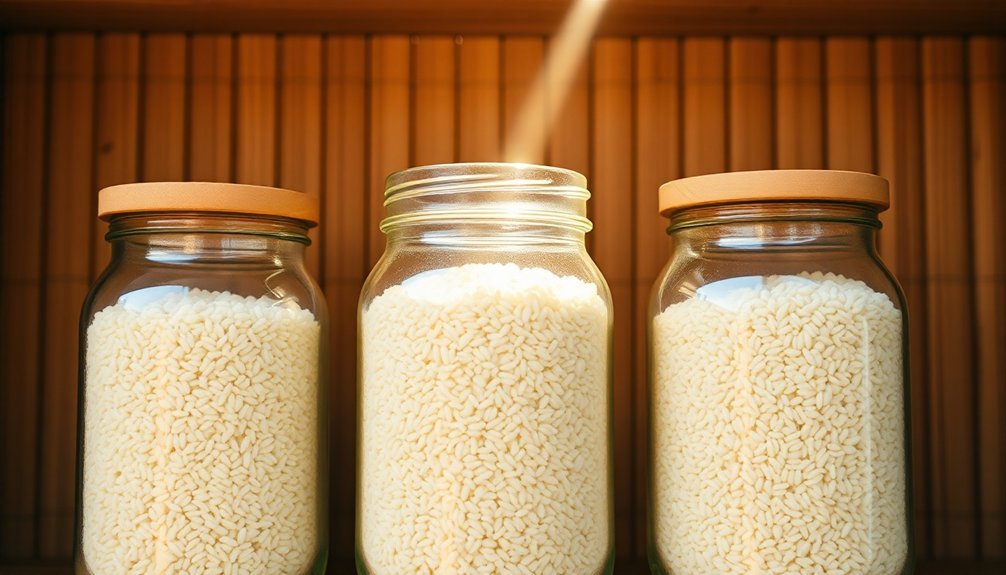
In line with modern environmental concerns, sustainable materials have revolutionized rice storage container options. You'll find eco-friendly alternatives that don't compromise on functionality while protecting both your rice and the environment. Rice husk and bamboo fiber containers lead the charge, offering biodegradable solutions that break down naturally without leaving harmful residues.
Key sustainable materials to evaluate include:
- Glass and stainless steel containers, which provide exceptional durability and can handle high temperatures while remaining completely food-safe.
- Food-grade silicone options that offer flexibility and space-saving features through collapsible designs.
- Ceramic containers that combine aesthetic appeal with practical benefits like temperature resistance and non-reactive properties.
When choosing your rice storage container, you'll want to assess materials that support a circular economy. Repurposed rice husk containers exemplify this approach, transforming agricultural waste into useful storage solutions.
These containers aren't just environmentally conscious – they're also UV stabilized for longevity and free from harmful chemicals like BPA and melamine.
For sun cooking enthusiasts, heat-resistant options like borosilicate glass or ceramic prove particularly valuable, as they can withstand temperature fluctuations while maintaining food safety standards.
Frequently Asked Questions
Can Rice Containers Be Used Directly in Solar Ovens?
You shouldn't use standard rice storage containers in solar ovens. Instead, use dark-colored, thin-walled metal pots with lids, as they'll absorb sunlight better and conduct heat efficiently for cooking your rice.
How Long Do Silicone Seals Last in Extreme Heat Conditions?
You'll find silicone seals typically last 5-10 years under extreme heat conditions. They'll maintain flexibility up to 230°C, though continuous exposure above 200°C can reduce their lifespan through gradual hardening and deterioration.
Which Colors Best Reflect Sunlight While Storing Rice Outdoors?
You'll get the best sunlight reflection with white or silver containers. Light metallic colors like aluminum are also excellent choices. Avoid dark colors, as they'll absorb heat instead of reflecting it away.
Do Different Rice Varieties Require Different Container Materials for Sun Exposure?
You'll need different containers based on rice type: use dark glass for brown rice's oils, clear containers for white rice, and UV-resistant plastic for basmati and jasmine to protect their aromatic compounds.
What Cleaning Methods Are Safe for Sun-Exposed Rice Storage Containers?
You'll need to hand wash sun-exposed containers with dish soap and hot water, or use a baking soda paste for tough stains. Vinegar works well for odors, and letting containers dry in sunlight helps sanitize them.
In Summary
You'll get the most value from heat-resistant rice storage containers that feature airtight seals and proper moisture control systems. Consider your cooking volume when selecting container sizes, and don't forget about easy dispensing features. Whether you choose glass, metal, or BPA-free plastic options, make sure they're specifically rated for sun cooking temperatures. Pick sustainable materials when possible to reduce environmental impact while protecting your rice.

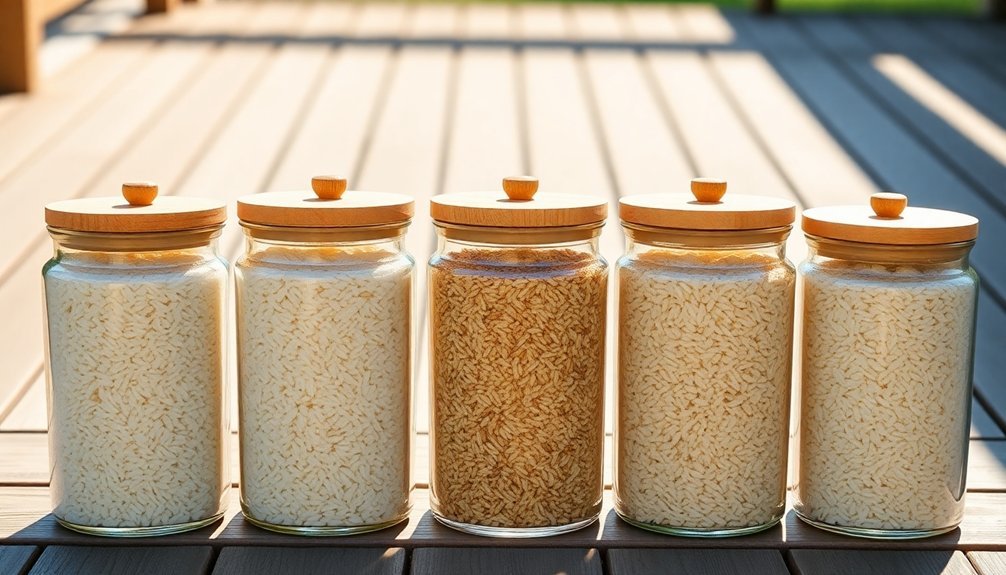
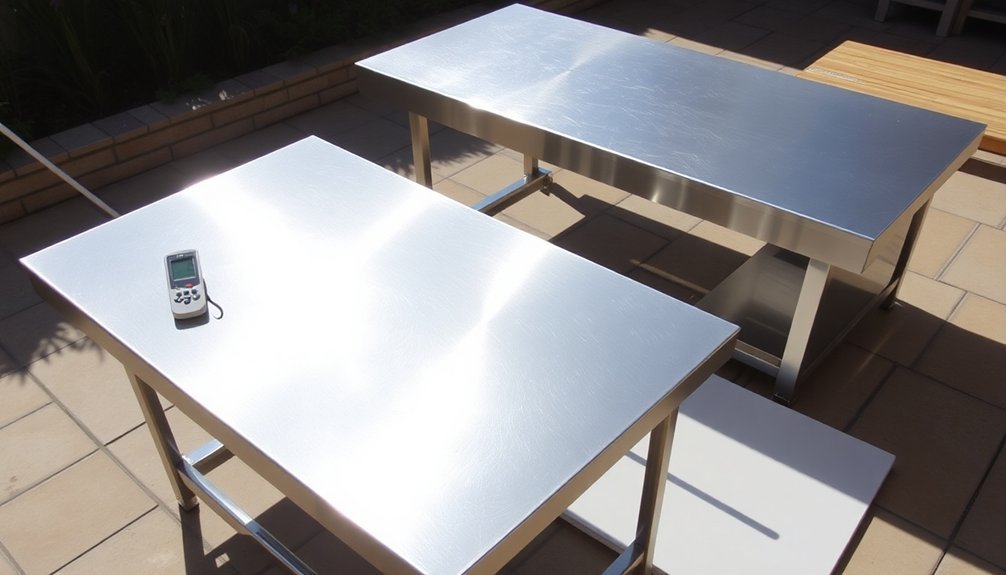
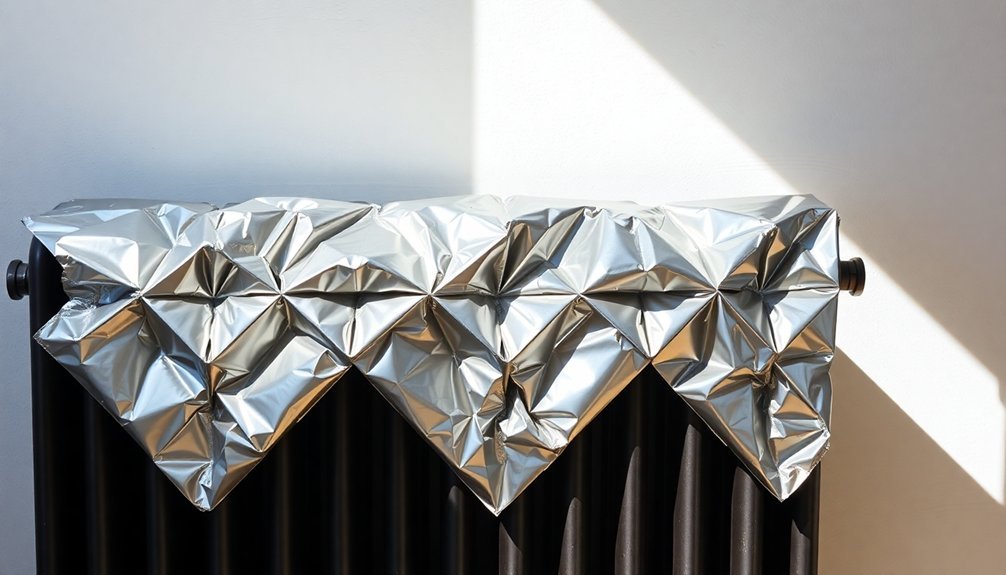

Leave a Reply